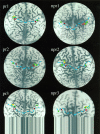Effects of regional anesthesia on phantom limb pain are mirrored in changes in cortical reorganization
- PMID: 9204932
- PMCID: PMC6793813
- DOI: 10.1523/JNEUROSCI.17-14-05503.1997
Effects of regional anesthesia on phantom limb pain are mirrored in changes in cortical reorganization
Abstract
The causes underlying phantom limb pain are still unknown. Recent studies on the consequences of nervous system damage in animals and humans reported substantial reorganization of primary somatosensory cortex subsequent to amputation, and one study showed that cortical reorganization is positively correlated with phantom limb pain. This paper examined the hypothesis of a functional relationship between cortical reorganization and phantom limb pain. Neuroelectric source imaging was used to determine changes in cortical reorganization in somatosensory cortex after anesthesia of an amputation stump produced by brachial plexus blockade in six phantom limb pain patients and four pain-free amputees. Three of six phantom limb subjects experienced a virtual elimination of current phantom pain attributable to anesthesia (mean change: 3.8 on an 11-point scale; Z = -1.83; p < 0.05) that was mirrored by a very rapid elimination of cortical reorganization in somatosensory cortex (change = 19.8 mm; t(2) = 5.60; p < 0.05). Cortical reorganization remained unchanged (mean change = 1.6 mm) in three phantom limb pain amputees whose pain was not reduced by brachial plexus blockade and in the phantom pain-free amputation controls. These findings suggest that cortical reorganization and phantom limb pain might have a causal relationship. Methods designed to alter cortical reorganization should be examined for their efficacy in the treatment of phantom limb pain.
Figures



References
-
- Adams HA, Biscoping J, Ludolf K, Borgmann A, Bachmann MB, Hempelmann G. The quantitative analysis of amide local anesthetics using high pressure liquid chromatography and ultraviolet detection (HPLC/UV). Reg Anaesth. 1989;12:53–57. - PubMed
-
- Aglioti S, Bonazzi A, Cortese F. Phantom lower limb as a perceptual marker of neural plasticity in the mature human brain. Proc R Soc Lond [Biol] 1994;255:273–278. - PubMed
-
- Arena JG, Sherman RA, Bruno G, Smith JD. The relationship between situational stress and phantom limb pain: cross-lagged correlational data from six month pain logs. J Psychosom Res. 1990;34:71–77. - PubMed
-
- Birbaumer N, Elbert T, Canavan A, Rockstroh B. Slow potentials of the cerebral cortex and behavior. Physiol Rev. 1990;70:1–41. - PubMed
-
- Birbaumer N, Flor H, Lutzenberger W, Elbert T. The corticalization of chronic pain. In: Bromm B, Desmedt JE, editors. Pain and the brain: from nociception to cognition. Raven; New York: 1995. pp. 331–344.
Publication types
MeSH terms
Substances
LinkOut - more resources
Full Text Sources
Medical
